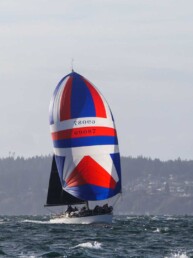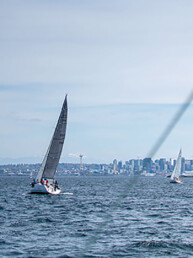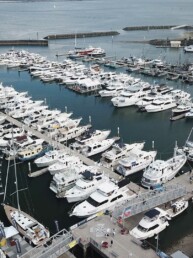
“Sorry to wake you, but we need all hands on deck right now.”
Somehow these words penetrated my deep sleep and I rolled off the bunk and struggled toward the companionway. I felt great urgency to get on deck, even though I wasn’t fully awake yet, or even quite sure of who or where I was.
“Peter, we have a traffic situation, I need you on deck. A light just came on!” I recognized the voice — Ginger — my partner and the only other person aboard our ketch, Irene. I understood the sense of urgency, as she never calls for help frivolously.
By the time I stumbled into the cockpit, peered to windward and was met with a lukewarm splash of seawater, I was fully oriented to time and place. Time, zero dark thirty … and place? We were in the South China Sea, making our way up the west coast of the Philippine island of Luzon, the winking white lights of fishing canoes surrounding us.
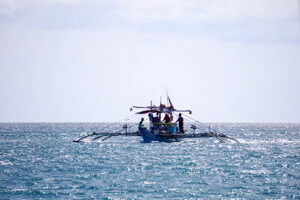
Ginger pointed to port, where a banca boat, a large outrigger canoe, was clearly on a converging course. Long poles set port and starboard streamed fishing lines. This was not the first time we had met a banca running dark, only to turn on a light at the last minute to avoid a collision. A glance at the helmsman told us that any collision avoidance was up to us. In the glare of a single blinding white light swinging in his rigging, we could see his determined face.
Since Irene was close-hauled on a port tack, we would be able to avoid collision easily by bearing off to starboard. But a glance to starboard showed a group of bancas not much farther away from us. Given our turning radius, we were blocked from bearing off.
“I think we’ve got to tack,” Ginger said. “I’ll handle the sheets if you steer!”
I sprang aft to the tiller, disconnected the windvane steering lines, glanced at Ginger and saw that she was ready to release the yankee sheet, then glanced again at the banca, whose skipper was peering back at me with alarm and determination. There was still enough room to tack and clear his fishing lines.
I put the helm down, shouted “Helm’s alee,” and … nothing. Irene rounded up a bit and the yankee jib luffed, but she did not tack. We instantly knew that Irene’s dirty bottom had reached a crisis point.
“She can’t tack!” I shouted. The banca skipper was angrily waving his arms. My brain struggled, my heart was pounding and I felt a rising panic. What to do?
Ever since departing Singapore, Irene’s performance had been deteriorating bit by bit. A few days earlier, we had looked over the taffrail and seen fronds of weed waving in our wake. A huge remora fish lurked in the ecosystem trailing behind us. Our average speed had been dropping daily. No wonder we can’t tack!
A small voice from some faraway part of my sleep-deprived brain suggested, “What about the engine?” Yes, that will do it! We fired up, pushed the throttle to the stop, and around we went. The banca skipper shook his fist and shouted something as he swept by us, having never altered course or speed at all. Ginger looked at me and we shook our heads in disbelief.
In normal times, we would likely not find ourselves struggling through fishing fleets at night. We were close to a coast with many fine anchorages. But we were sailing during COVID-19 and were forbidden to stop. We were on a long nonstop passage from Singapore, where we had sat on a mooring for months (see 48° North, May 2022) to Japan, where we expected to receive visas and be allowed to cruise and go ashore. Our course took us past Malaysia, Indonesia, Vietnam, Brunei, Taiwan, and the Philippines, all places we would have liked to cruise and visit. But Japan was the only country in the region that would let us ashore.
Japan’s entry requirements specified that we needed to arrive at our port of entry on an exact date. By the time we encountered that banca off Luzon, we were a bit behind schedule and pushing hard, focused on making that promised date come true. We had been aboard Irene for hundreds of days without relief, and the thought of Japan turning us away because we were too late was a grim one. We were determined to arrive exactly on time.
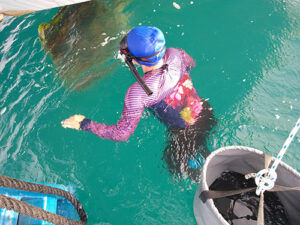

The morning after Irene’s refusal to tack, we arrived at a river mouth. There, protected by mangroves and far away from any coast guard station, we surreptitiously anchored for a couple of nights. We caught up on sleep and spent the daylight hours in the water scraping marine growth off Irene’s bottom. A banca or two motored near to sell us fish and we cheerfully waved, hoping no official would find out that we were there.
Tropical storm Dujuan, named by the Japan Meteorological Agency, was forecast to become a typhoon and pass directly overhead, and should we be questioned, our honest defense would be that we were seeking shelter from that storm. No official vessel discovered us, thankfully, and we resumed our trek north after the typhoon remnant passed overhead.
In our normal cruising routine, we would never let Irene’s bottom get so foul. We would haul out and apply fresh bottom paint as we had in Turkey 12 months prior, but we hadn’t had an opportunity since. During the five months we had been stationary, swinging on a mooring at Changi Sailing Club in Singapore, we had been in a constant battle with marine growth. During that time, both of us dove on the bottom with scrapers almost weekly and still couldn’t keep up. The water was dirty, brackish, murky and hot.
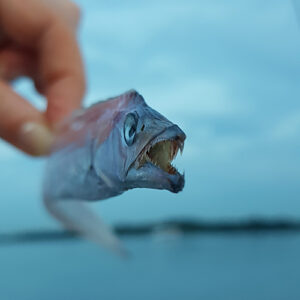
We were close to the equator, and monkeys, lizards, and snakes swam by regularly. It was so murky that remora fish would swim between our faces and the hull as we scraped. Major paint manufacturers maintained several barges nearby with test samples immersed in the water. Nearby there were several boatyards capable of hauling Irene, but since we were in quarantine, that option was out of the question.
Our stay in Singapore might have been a disaster — a married couple cooped up in a small space in equatorial heat for months. But it turned out not to be. One positive was the fact that we were connected to the world by the internet. Shopping was easy. Ginger ordered food online and Peter would row ashore in the dinghy and pick it up. Netflix helped, we had Zoom meetings, and we got the news of the world. We watched in horror as death tolls rose and as the USA became the world’s country worst hit by the pandemic. We felt very safe in our isolated situation.
Every week we watched the sailing club races and cheered on our favorites. Kind yacht club members waved and dropped off fresh bread and other delicacies as they passed by. Every two weeks we slipped the mooring and motored to the pontoon where we could refill our water tanks. A good part of the world’s shipping passes down the channel past Changi, and we enjoyed ship watching.
After a month or so, regulations relaxed a bit and we were allowed to visit the two other ocean cruising vessels that sat on moorings there, including author Fatty Goodlander and his wife, Carolyn, aboard their ketch, Ganesh. They were allowed to visit us too, and we enjoyed weekly social time. The months passed by quickly enough and when the timing was correct to depart on the next leg homeward (a nonstop passage to Japan) we were relaxed, fully provisioned, and ready to go.
The wind was brisk as we sailed north. Our spirits were high and it was good to be moving again. As we entered the strait, a Singapore patrol vessel called on the VHF radio to warn us of a dangerous shoal in the area. The reef was well-charted and not a surprise to us, and Ginger, our communications officer, thanked them for the warning. It was great to be performing our familiar passagemaking roles and in open waters with a good, strong wind.
There were a couple of items of concern for us, though. The pilot charts showed that our trip would likely be upwind all 3,000 nautical miles to Japan. As a full-keel heavy displacement ketch, Irene’s fastest point of sail is not upwind work — especially with her sails worn and blown out of shape and her antifouling paint expired. And we had that hard and fast deadline to arrive in Japan. We were explicitly warned not to arrive late, or on the wrong day or in the wrong port. But like most sailors, we love a challenge and our race with time was on.
Another item of concern was that as we sailed up the Palawan Channel, we would be exposed to two dangers. To starboard, the murderous, crack-addicted pirates of Abu Sayyaf had very recently been active, recruiting, abducting and killing islanders. To port, geopolitical tensions were high in the atolls of the Spratly Islands as China militarized the area. When we arrived at Palawan, we joked that we would tack to port when we got too close to pirates and to starboard when we got too close to the Chinese Navy. We breathed a big sigh of relief when a welcome wind shift allowed us to sail quickly up the second half of the channel on one long starboard tack.

One more danger had our attention: This part of the world can experience typhoons any time of the year. Sailing up the coast of Luzon, we received warnings that a typhoon was developing nearby and was expected to go directly over our planned route, even though it was the season of lowest typhoon risk. Worse, this typhoon was forecast to deliver gale-force headwinds. This was the storm that provided us an opportunity to clean the bottom — and luckily by the time it came upon us, it had diminished to a mere gloomy, squally day and the headwinds we had dreaded never materialized again.
North of the Philippines we encountered fresh Pacific tradewinds and made good time, reeling off the miles on a long starboard tack. Unfortunately, progress was stopped for a while with a short but sharp gale directly on our nose as we entered Japanese coastal waters. We jogged back and forth for a long night in the lee of Taketomi Island to avoid losing ground. We estimated that we might lose as much as 20 miles of hard-earned progress if we hove-to.
Concerned Japanese Coast Guard officials hailed us on VHF, having received our AIS signal. They were wondering what we were doing and gave us permission to remain in the area until the wind eased. Early the next morning we resumed our race north again. We weren’t sure if we could still make our appointment at the port of Naha, Okinawa in time. It was a nailbiter, as the wind continued to ease, but we made it with no time to spare!

Dozens of uniformed officials met us at the wharf and after hours of formalities, we were given permission to go ashore for the first time in almost eight months. After the last form was filled out and the last official left, we hugged each other, giddy with happiness. We stepped ashore and the unmoving ground felt strange yet good under our feet. Our balance was off and we wobbled a bit as we walked, as if we were slightly intoxicated.
Once another quarantine was complete, we were free to roam on land for the first time since departing Turkey almost nine months earlier. We had documents allowing us to cruise Japanese waters for three months. After that, at the end of May, we planned to depart on the final section of our long trek: a passage to the Aleutian Islands and Dutch Harbor, then from there, a crossing directly across the Gulf of Alaska to Neah Bay and home!
Originally from Seattle, Peter and Ginger Niemann now call Port Townsend home after two circumnavigations. They were awarded the Cruising Club of America’s Blue Water Medal in 2022.

